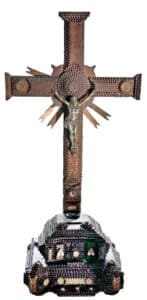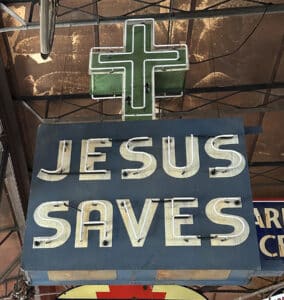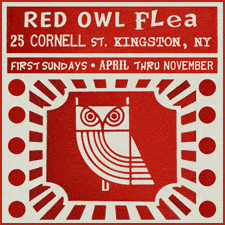by Rob Wolfe of American Pickers
For centuries, collecting religious artifacts and iconography has been a pursuit that transcends time, geography, and personal beliefs. These objects often hold profound significance for collectors, whether as expressions of deep spiritual connection, links to cultural heritage, or tangible pieces of history. Exploring the motivations and stories behind these collections offers a glimpse into the diverse ways people connect with faith, tradition, and artistry.
For collectors drawn to items by a spiritual connection, religious artifacts such as crosses, prayer beads, icons, and relics offer a profound and tangible link to faith and devotion. These cherished items often evoke a deep sense of reverence and inspiration, serving as both personal touchstones and symbols of belief. Many collectors prominently display these artifacts in their homes, creating sacred spaces that reflect their spiritual identity and commitment.
Collectors drawn to religious artifacts for their historical significance often have distinct preferences and criteria. These pieces are treasured not only for their association with a specific religion, region, or tradition but also for the unique role they played in shaping or reflecting that history. Older artifacts, in particular, embody the culture, craftsmanship, and spiritual beliefs of their time, offering a fascinating glimpse into the past. For these collectors, each item becomes a bridge to a bygone era, rich with stories and meaning.
When it comes to the artistic appeal of religious items, the craftsmanship is often highly decorative. Some of the most valued items are intricately designed with precious materials. Working with rare or precious materials requires a high degree of artistry and craftsmanship, added to their value. This also makes them appealing to art enthusiasts and collectors alike.Of course, other collectors are drawn to the sentimental value of items or the ancestral connection of items. These individuals collect items tied to their family’s religious practices or heritage. These pieces may hold personal value and connect them to past generations.

• Age: Older items, particularly those from significant historical periods, are typically more valuable – especially if they remain in good condition.
• Provenance: Items with a well-documented history or connections to notable events or figures in religious history are highly sought after by collectors.
• Craftsmanship and Materials: Artifacts crafted from precious metals, gemstones, or those attributed to renowned artisans often command a premium due to their superior quality and artistry.
• Condition: The better preserved the item, the more desirable and valuable it becomes in the marketplace.
• Rarity: As with all antiques and collectibles, items produced in limited quantities or unique pieces, such as relics or one-of-a-kind artifacts, tend to fetch the highest prices.
Each of these factors contributes to the intrinsic and market value of a piece, making the study and collection of religious items a fascinating pursuit for enthusiasts and historians alike.

However, some collectors value items more for their personal significance than for monetary worth. In my collecting practices, I tend to value the emotional connection to an item and the stories behind each piece, whether it’s a vintage crucifix, an ornate icon, or an old Bible.
Most of the items that I bought over the last 40 years have had a personal connection. And for me, when I talk about the value of an item, I truly believe that value is in the eye of the beholder. I’ve paid anywhere from $200-$5,000 for certain items. For me, collecting religious artifacts is a way of honoring the past and keeping these unique objects accessible for future generations to appreciate.
Best known for his co-hosting role on The History Channel’s long-running hit, American Pickers, Rob Wolfe is also a seasoned antique dealer. From vintage signs to antique cars and motorcycles, and everything in between, Rob has an extensive knowledge of, and passion for, all things antique. He’s been collecting unique items and learning about their history since early childhood and today that passion can be seen at his showroom in Bettendorf, Iowa, where Rob hosted the annual Bettendorf Americana Car show and Antique Auction.





Related posts: